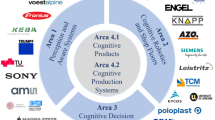Abstract
This article describes the control of moving robots in an autonomous decentralized flexible manufacturing system (FMS) by changing the mind of the moving robot. In an autonomous decentralized flexible manufacturing system where a lot of moving robots operate, there are problems of path interference. There is an existing method which we have developed called AAA, and this is used to evade these interference problems. However, using this method, it is very difficult to grasp entirely the innumerable path interference situations that really occur. Therefore, to evade these unexpected situations flexibly, we propose a mind model, which is the complicated expression of combinations of three elements: stimulation vector, unit, and load. Even if a familiar situation happens, moving robots can make different actions when their mind is changed.
Similar content being viewed by others
Explore related subjects
Discover the latest articles, news and stories from top researchers in related subjects.References
Scassellati B (2002) Theory of mind for a humanoid robot. Auton Robots 12:13–24
Kaighobadi M, Venkatesh K (1994) Flexible manufacturing systems: an overview. Int J Oper Prod Manage 14:26–49
Kost GG, Zdanowicz R (2005) Modeling of manufacturing systems and robot motions. J Mater Process Technol 164–165:1369–1378
Yamamoto H, Ramli R (2006) Real-time decision making of agents to realize decentralized autonomous FMS by anticipation. Int J Comput Sci Network Security 6(12):7–17
Ramli R, Abu Qudeiri J, Yamamoto H (2007) Anticipating action decisions of automated guided vehicle in an autonomous decentralized flexible manufacturing system. Int J Intell Technol 2:1–27
Author information
Authors and Affiliations
Corresponding author
Additional information
This work was presented in part at the 14th International Symposium on Artificial Life and Robotics, Oita, Japan, February 5–7, 2009
About this article
Cite this article
Yamamoto, H., Kikuchi, H., Yamada, T. et al. Moving robot’s mind of autonomous decentralized FMS and mind change control. Artif Life Robotics 14, 34–38 (2009). https://doi.org/10.1007/s10015-009-0717-7
Received:
Accepted:
Published:
Issue Date:
DOI: https://doi.org/10.1007/s10015-009-0717-7




